It’s getting hot outside. Actually scrap that, it already is hot out, and in some places it’s getting even hotter! Which means our poor little airplanes are suffering, struggling, sweating their little airplane socks off.
We’ve written up some bits on this before, and you know it all already – watch the temperatures, watch the performance, watch the climb gradients, watch the big old storms puffing up around hot spots.
If you want a full recap then you can read that all here.
Here’s a quick refresher.
A swig of cool lemonade for the pilot brain…
- Planning: Make sure you’re not at risk of heading outside the operating envelope.
- MELs: Check the APU, the packs, basically anything that produces cold air because if there are problems there, you might need to think about your crew, passengers and freight too.
- Engines: Keep an eye on them, particularly during start.
- Brakes: Watch them brake temps. Plan the taxi, and think about how best to brake to keep them as cool as you can.
- Fuel: It has hot limits as well as cold limits.
- Performance: Yup, hot = not so dense = not so good.
- Climb: Hot, high, heavy? You might not meet those restrictions and it’s better knowing that before you go than trying to drag your airplane up over stuff.
- Approach and Landing: Turbulence from thermals can get testing.
And here are some pointers on the really ‘scorching’ issues…
Batteries.
The one in your airplane is fixed so not much you can do about it other than turn the APU on/ plug in some cold air tubes or push your airplane into a shady hanger. But all the other removable bits filled with Lithium Ion batteries are worth considering.
Things like your Defibrillators for example. These usually have max temperatures (50 degrees rings a bell) so you may find you need to move them, remove them, take them off with you overnight.

Took this directly from a big manufacturers website.
Cargo
Passengers can complain and you can throw water on them. Cargo less so.
A sad result of excessive heat at KMIA/Miami airport was the death of thousands of baby chicks recently. Whilst air temperature might be reading ok, asphalt can be 40-60 degrees F hotter than the air around it.
Storms
Hot weather means storms. If you see something in front of you, or on the weather radar, be careful about going over the top – if they are building then you’re going to meet some pretty rough air up there if you aren’t well clear.
A general recommendation is 5000’ for big’uns.
Then there are tornadoes.
Actually, the number of days each year that see tornado activity has fallen, but the number of mega outbreaks (30 or more in a day), the density of clusters and the general strength have gone up. So 3:1 to tornadoes really.
NOAA has a tornado watch page that is worth watching (checking out during the season).
The National Weather Service Twitter account is also a good spot for live updates.
They can be hard to predict, but do cause disruptions if they are near airports (not to mention potential damage). Texas is the most hit state, but there have been numerous warnings and watches out across the US including Pennsylvania, Ohio of late.

GET OUTTA THERE you fools!
And then there are fires.
Wildfires are cropping up across the US. This site is good for monitoring these.
The risk of fires to aviation is less burning destruction, and more smoky ash visibility reduction. They can also create a secondary risk from increased airborne firefighting traffic in the areas.
Europe has seen a big increase in serious wildfires this this year, with the Mediterranean area particularly badly affected. Portugal, Spain, Greece, Italy, Croatia – all burning to varying degrees. This may cause some inflight disruption, and may cause parking issues and ground disruption particularly at smaller airports.
Humidity
This is for you and your passengers.
India in particular has been hitting the ‘wet-bulb’ limit for human survival. Sounds doomsdayish? Well, it can be.
The wet-bulb temperature is basically what you get if you wrap a water soaked cloth around a thermometer. If this exceeds around 35 degrees C then that’t the time to really start sweating, so to speak, because above this we actually become unable to reduce our body temperature even by sweating, sitting in the shade, or drinking water. Prolonged exposure to this will result in potentially fatal heatstroke.
So keep an eye on the temperature, the dew point, and any staff you have outside!
Environmental stuff.
The real reason I wrote this post…
It was so hot in England (yes, England!) that EGGW/Luton airport’s runway melted. OK, melted might be an exaggeration, but a chunk of asphalt shifted and caused a lot of disruption for a day, and it was only only 37 degrees C.
EGVN/Brize Norton experienced a similar problem.
Airports, or rather the folk who manage them, in the likes of Dubai and the Middle East are used to these temperatures and what it can do to asphalt, which is probably why they regularly overhaul them. But places less familiar with soaring temperatures aren’t.
Watching those Notams is the best advice for this.
Keep an eye on airports in countries with less infrastructure as well. Again, India has been struggling with power cuts and blackouts due to extreme temperature and this may well impact airports just as much.

More patchy than melted.
Climate change?
Here is something Eurocontrol said about it all. Don’t worry, it’s not a “what to do about it” lecture, but more “things to look out for because of it” guidance.
More on the topic:
- More: Top Tips for Operating in the Heat
- More: Safety on the NAT: B+ with room for improvement
- More: The Seven Deadly Things
- More: SNOWTAMS slip into a new style
More reading:
- Latest: Venezuela & Caribbean Airspace Update
- Latest: ReFuelEU: Europe’s new anti-tankering rules explained
- Latest: US CBP biometrics: BizAv rollout still unclear
- Safe Airspace: Risk Database
- Weekly Ops Bulletin: Subscribe
- Membership plans: Why join OPSGROUP?











 Get the famous weekly
Get the famous weekly 






Hi, how about airports coming up with APU restrictions due to noise VS airplanes that do not have cooling air intake. Crew accept these limitations without realizing they are exposing themselves to extremely hot temperatures in the cockpit with health risks on ground and in the air as well.
No mention of fuel specific gravity in hot weather?
Hmm, no, thought it was in the earlier post. So – watch the specific gravity of your fuel. It changes. Hot temperature = less capacity (it expands). The changing temperature of fuel could also affect the quantity readings in flight (to a small degree).